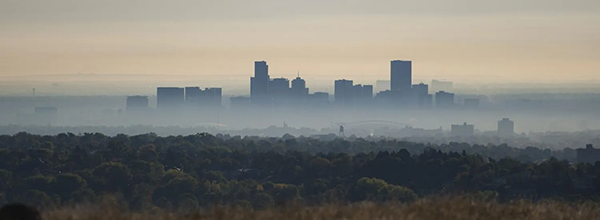2024 News & Events
Communities of color breathe Denver's worst air
21 February 2024
adapted from the story by CIRES Communications

History determines who gets to breathe fresh air, according to a new study published today in Environmental Science and Technology. The study found that historic, discriminatory lending practices known as redlining in the city are linked to inequities in air quality today.
Alex Bradley, a fourth-year chemistry Ph.D. student in the CIRES de Gouw lab at the University of Colorado Boulder, used his background in chemistry coupled with an environmental justice lens to understand how pollution impacts communities of color in Denver.
What he discovered wasn't surprising: People of color, specifically those of Hispanic/Latino and American Indian/Alaska Native heritage, are exposed to higher levels of air pollution than non-Hispanic whites.
The difference is due to where the groups tend to live, with people of color typically residing in historically redlined neighborhoods many decades after the practice ended. They also tend to live nearer to highways.
The work is in line with growing work showing communities of color experience worse air quality around the country.
"We just focused on Denver and redlining practices that took place in the 1930s and 1940s," said Bradley. "And that's important, because I think that every city has a story of why people live where they do, and that affects who is affected most by pollution."
Joost de Gouw, CIRES Fellow and professor of chemistry, said the study's focus on history coupled with multiple data sets make it the first of its kind.
"Denver has some known, large sources of air pollution that are outside the city boundaries, like agriculture, oil and gas production, and wildfires," said de Gouw. "So going into the study one could have expected that people in Denver are exposed more evenly to air pollution. But that is not what we found. It still matters where you live and how close you are to industrial sources and highways inside the city boundaries."
To take a comprehensive look at air quality disparities in Denver, the paper focuses on two pollutants: nitrogen dioxide and particulate matter (NO2 and PM2.5). Nitrogen dioxide comes from vehicles and power generation. It is a known source of ozone pollution in the summer and particulate matter in the winter. Sources of particulate matter include vehicle exhaust, cooking, and wildfires, and PM2.5 is hazardous to human health, causing nearly 9 million deaths in 2015. Bradley, de Gouw, and their colleagues used satellite images and satellite-based models to measure pollution throughout the city.
They combined satellite data with historical redlined maps created by the Homeowners' and Loan Corporation (HOLC), which graded neighborhoods A-D, and allowed for Federal Housing Administration to deny loans in lower-graded neighborhoods.
"We find districts that were graded A in 1939 have lower air pollution than the districts that were graded D," said Bradley.
The authors then used 2020 census tracks to find a correlation between pollution and race to further quantify their results. They discovered that non-Hispanic white and Asian/Asian American populations experience far less air pollution than Hispanic/Latino, and American Indian and Alaska Native communities.
The group applied the same process to 200 other cities in the United States that also redlined. The results were similar across the board: People of color fare worse today, while non-Hispanic whites fare better.
Finally, the authors looked at transportation, with its known impact on air quality. In the 1960s Denver built highways through many redlined districts. Bradley and de Gouw tapped colleagues in NOAA's Chemical Sciences Laboratory, Colin Harkins and Brian McDonald, who provided data from FIVE, the Fuel-based inventory of Vehicle Emissions, which tracks fuel emissions throughout the city.
Emissions from traffic, both gas and diesel emissions, are higher in census tracks inhabited predominantly by people of color, who are more likely to live closer to major highways.
Bradley hopes providing the first in-depth study of Denver's air quality impacts on communities of color will provide a tool for change.
"People living in these communities will not be surprised by our data," Bradley said. "I hope this work helps others recognize these issues are real and quantifiable."
Bradley, A., B. Croes, C. Harkins, B. McDonald, and J. de Gouw, Air pollution inequality in the Denver metroplex and its relationship to historical redlining, Environmental Science & Technology, doi:10.1021/acs.est.3c03230, 2024.
Abstract
Prior studies have shown that people of color (POC) in the United States are exposed to higher levels of pollution than non-Hispanic White people. We show that the city of Denver, Colorado, displays similar race- and ethnicity-based air pollution disparities by using a combination of high-resolution satellite data, air pollution modeling, historical demographic information, and areal apportionment techniques. TROPOMI NO2 columns and modeled PM2.5 concentrations from 2019 are higher in communities subject to redlining. We calculated and compared Spearman coefficients for pollutants and race at the census tract level for every city that underwent redlining to contextualize the disparities in Denver. We find that the location of polluting infrastructure leads to higher populations of POC living near point sources, including 40% higher Hispanic and Latino populations. This influences pollution distribution, with annual average PM2.5 surface concentrations of 6.5 μg m–3 in census tracts with 0–5% Hispanic and Latino populations and 7.5 μg m–3 in census tracts with 60–65% Hispanic and Latino populations. Traffic analysis and emission inventory data show that POC are more likely to live near busy highways. Unequal spatial distribution of pollution sources and POC have allowed for pollution disparities to persist despite attempts by the city to rectify them. Finally, we identify the core causes of the pollution disparities to provide direction for remediation.